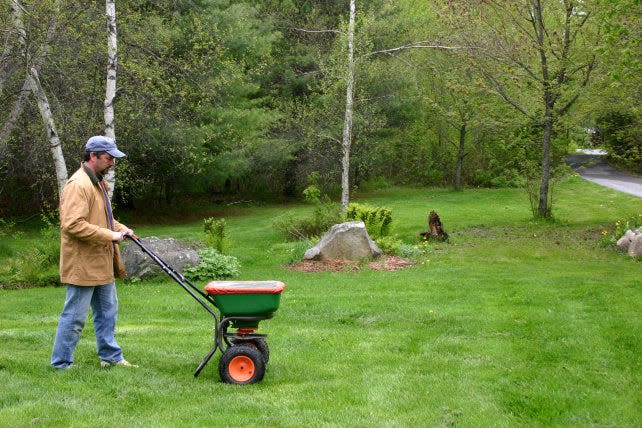It's not too early to follow these five tips for a healthy spring lawn
Tomorrow is the first day of spring and even though a dusting of snow may have covered your lawn this past week, it’s not too early to begin planning for spring lawn maintenance tasks. Lawn grasses have begun to green up over the past 10 days in Greater Columbus and one anxious homeowner in my neighborhood has already fired up the lawnmower and completed the first cut of the season.
Here are five tips for spring lawn care that can help you have a lush, dense, green lawn this year:
Tip #1: Understand the job
Remember that turf grasses are perennial cool season plants, which means that they are plants which come back year after year, and that they grow best in the cool moist conditions of spring, fall and even winter. Summer, with its hot and many times dry weather, is actually a period of stress for turf grasses, which requires us to give extra attention to the lawn in early spring if we expect it to survive the challenging conditions of summer.
Tip #2: Control weeds early
The best time to control weeds is before they ever germinate, so if your lawn contained weeds such as dandelion, plantain, ground ivy or any other broadleaf weed last season, applying a pre-emergent herbicide early this spring can reduce the potential for these weeds to invade your lawn later this growing season. A pre-emergent herbicide is a chemical which prevents seeds from germinating.
Early greening: How is warmer-than-normal Columbus weather affecting your lawn and garden?

Early spring is also the best time to control crabgrass with a pre-emergent herbicide if this pesky annual grass weed crept into your lawn late last summer. Most crabgrass preventers require the soil temperature to be at least 55 degrees Fahrenheit for maximum effectiveness, and soil temperatures are near 50 degrees Fahrenheit in Greater Columbus this week, so we should aim to apply crabgrass preventers in the next week to 10 days. A good phenological rule of thumb is to apply crabgrass preventers in Greater Columbus when forsythia begins to bloom.
Tip #3: Reseed bare spots early
If you have bare spots in your lawn or areas of lawn where the stand of grass is thin, early spring can be a good time to reseed these bare areas and over seed any thin stands in the lawn. Too often, we fail to reseed early enough in the spring and the resulting new grass seedlings don’t survive the harsh conditions experienced during the hot and dry summer months.
Many times, we don’t notice areas of the lawn which are in need of reseeding until after we mow the lawn the first several times in spring, and by that time, it is difficult for grass seedlings to develop root systems needed to survive the warm, dry conditions of summer. So, before you mow your lawn for the first time this season, walk around the lawn and do a critical inspection to assess the presence of bare spots and thin stands.
If you have large areas of the lawn that need reseeding or you wish to renovate the entire lawn with a completely new seeding, late summer and early fall may be a better time for reseeding. Grass seedlings that emerge from a late summer or fall seeding tend to be more successful in Greater Columbus because they have two cool seasons (fall and winter) to develop root systems before they are exposed to the hot and dry conditions of late spring and summer.

Tip #4: Fertility is key to grass survival
Turf grasses, like most green plants, require adequate amounts of three soil nutrients: nitrogen (N), phosphorus (P), and potassium (K). While phosphorous and potassium are stored in the soil from year to year, nitrogen does not persist in the soil and must be applied each year for lawns to remain productive and healthy. Early spring and late fall are the critical times of year to complete this lawn-management task.
Lawn fertilizers should be split into three applications made at the time of the year when grass plants require nutrients: late spring, late summer and late fall. If you did not apply fertilizer to the lawn last fall, you can make an application now to provide adequate nutrients for green-up and early-season growth.
Tired of lawn mowing?:Consider alternatives to grass for easier maintenance
Tip #5: Don't over-apply fertilizer
Only the exact amount of fertilizer needed by your lawn should be applied in order to save money and protect the environment, and the only accurate method for determining exactly how much fertilizer is needed is to have your soil tested for fertility. The Franklin County Office of OSU Extension offers soil testing for home lawns, and information about soil testing can be found online at: go.osu.edu/franklinsoiltesting.
When applying lawn fertilizers, be sure that the fertilizer is only applied to soil and is not accidentally spread on paved driveways, sidewalks or streets where it can be washed into storm sewers and eventually end up in surface waters such as streams and lakes, where it contributes to algal blooms.
Mike Hogan is an Extension educator, Agriculture and Natural Resources, and associate professor with Ohio State University Extension. hogan.1@osu.edu
This article originally appeared on The Columbus Dispatch: Five tips for spring lawn care from Mike Hogan
